Recent Advances in UHMWPE/UHMWPE Nanocomposite/UHMWPE Hybrid Nanocomposite Polymer Coatings for Tribological Applications: A Comprehensive Review
Abstract
:1. Introduction
2. UHMWPE Coatings for Different Applications
2.1. UHMWPE Coatings for MEMS Applications
2.1.1. Approach 1: A Bi-Layer Composite Coating of UHMWPE with an Overcoat of Perfluoropolyether (PFPE) Lubricant
2.1.2. Approach 2: Chemisorption of Polar UHMWPE on Si Substrates with an Intermediate Layer of GPTMS SAM
2.1.3. Approach 3: A Bi-Layer Composite Coating of UHMWPE with an Intermediate Hard Layer
2.1.4. Approach 4: Interfacial Energy Modifications of the Si Substrate to Improve the Tribological Performance
2.1.5. Summary
- Pre-Treatment of the Si Substrate (Piranha Treatment): A proper pre-treatment of the Si substrate so that the surface is devoid of any hydrocarbons or impurities and also increasing the wettability of the surface so that it will help in improving the adhesion of the coating to the substrate, which in turn affects its tribologial performance. In the literature presented above [52,53,54,55,56,57], they used a piranha treatment, which was very effective in cleaning and improving the wettability of the surface. The steps in piranha treatment include the following:
- ○
- Si substrates were rinsed for 1 min and ultrasonically cleaned for 15 min each, first with soapy water, second with distilled water and finally with acetone.
- ○
- The cleaned substrates were blow-dried with pure nitrogen gas and immersed into a piranha solution (70 vol% H2SO4 and 30 vol% H2O2) at a temperature of 120 °C for an hour to remove any contaminants.
- ○
- After that, the substrates were rinsed again with distilled water and acetone for 1 min each.
- UHMWPE Coating Procedure (Dip-Coating Process): In the literature presented above, all the UHMWPE coatings were deposited using a simple dip-coating process, which helped obtaining coatings with uniform thickness. The thickness of the coating could be controlled by changing the wt.% of UHMWPE powder used to prepare the dip-coating solution by following the procedure listed below:
- ○
- The first step in the preparation of the UHMWPE coatings was the dissolution of the right amount (wt.%) of UHMWPE polymer powder into decalin. This is carried out at a higher temperature of 170 °C to 180 °C, which results in complete and uniform dissolution of the polymer.
- ○
- Magnetic stirring is used during the heating process in order to enhance the rate of dissolution.
- ○
- After ensuring the complete dissolution of the polymer powder, dip-coating is carried out almost immediately using a dip-coating machine.
- ○
- The dip-coating is carried out at a constant dipping and withdrawal speed of 2.1 mm/s and an intermediate soaking time of approximately 30 s.
- ○
- After dip-coating, the samples are slightly dried in the air and then heated at 100 °C for approximately 20 h in clean air furnace.
- ○
- After thermal treatment, the samples are cooled to room temperature at very slow cooling rate (furnace cooling) to obtain coatings of uniform thickness.
2.1.6. Development of an Alternative Pre-Treatment Process for Si Substrates for Better Adhesion
2.2. UHMWPE Coatings for Mechanical Bearing Applications
2.2.1. Approach 1: Improving the Adhesion between the UHMWPE Coating and the Substrate Along with a PFPE Lubricant Overcoat
2.2.2. Approach 2: Improving the Load Bearing Capacity of the UHMWPE Coating by Reinforcing It with Nanofillers to Fabricate Nancomposite Coatings
2.2.3. Approach 3: Improving the Tribological Performance of the Uhmwpe Coating by Reinforcing It with More Than One Nanofiller to Fabricate Hybrid Nanocomposite Coatings
2.2.4. Summary
Coating Deposition Techniques
- Cleaning of the substrate: The substrates are cleaned thoroughly to make the surfaces devoid of any grease, oil, hydrocarbons and impurities to improve the adhesion with the coating. In all the cases presented, the substrates were cleaned with acetone or ethanol and then drying it with dry air or nitrogen.
- Pre-treatment of the substrate: Pre-treatment of the substrate is one of the very important steps in the coating procedure as it helps in improving the adhesion of the coating to the substrates, which in turns effects its tribological performance.
- Air-Plasma Treatment: The most favorable pre-treatment procedure in the deposition of the UHMWPE and its composite coatings has been found to be air-plasma treatment, irrespective of the substrate material. Substrates were placed in a Harrick Plasma Cleaner/Sterilizer under vacuum at an RF power of 30 W for approximately 5 min. Air-plasma treatment has been found to be an effective pre-treatment method, which is environmental friendly, easy to use, very flexible/adaptive, cost effective and less time consuming [60,61,62,63,64,66,67,68,69,70,71,72]. Air-plasma treatment helps in cleaning the surface by carbon cleaning effect and at the same time functionalizes the surface with carboxyl and hydroxyl groups which in turn increases the wettablility/surface free energy of the surface leading to an improved adhesion between the coating and the substrate. Figure 13 shows a schematic of the air-plasma treatment.
- Grid blasting: Han et al. [65] used grid blasting followed by pre-heating the substrate to a temperature of 110–130 °C.
- Preparing the composite powders solution or dry powders by using different dispersion techniques: Dispersion of the nanofillers is a crucial step in the preparation of nanocomposite coatings as it determines the final mechanical properties of the prepared coatings. Researchers have used different techniques to disperse the nanofillers uniformly in the UHMWPE polymer matrix depending upon the coating technique used. The various techniques used are explained below.
- Nanopowder solution from dip-coating: Dip-coating has been used by [60,61,62,63,64,66,67] to coat steel, aluminum and PEEK substrates with UHMWPE and UHMWPE composite coatings reinforced with CNTs. The nanopowder solution for dip coating was prepared by plasma treating the CNTs in the Harrick Plasma Cleaner/Sterilizer by uniformly spreading it out in a flat dish. The required amount of plasma-treated CNTs were then subsequently added to a measured quantity of decahydronapthalene (decalin), which is the solvent used to dissolve UHMWPE polymer. The CNTs were sonicated for 12 min using a probe sonicator with an amplitude of 30% and a cycle on/off time of 20/5 s to ensure uniform dispersion of CNTs in decalin. Required amount of UHMWPE depending upon the concentration needed, is added to the mixture of CNTs and decalin and the whole mixture is subjected to magnetic stirring for 20 min to ensure proper mixing of CNTs and UHMWPE. The mixture is then heated to a temperature of 170 °C for 1 h to completely dissolve the UHMWPE powder. Magnetic stirring is used throughout the heating process for uniform heat distribution, which aids in the complete dissolution of the UHMWPE powder.
- Nanopowders for electrostatic spray coating: The electrostatic spray coating technique has been used by [68,69,70,71,72], to deposit the coatings on steel and aluminum substrates. The nanopowders were prepared by ultrasonicating the required amount of fillers in 50 mL of ethanol using a probe sonicator with an amplitude of 30% and a cycle on/off time of 20/5 s for 10 min followed by magnetic stirring for 2 min to ensure uniform dispersion. Weighted amount of UHMWPE powder is then added to the solution and subjected to magnetic stirring for another 60 min. The UHMWPE/filler solution is then subsequently heated to a temperature of 70 °C on a heating plate for 24 h to ensure the complete evaporation of ethanol leaving behind dry nanopowder.
- Coating deposition techniques: In the literature, four different techniques have been used to deposit UHMWPE composite coatings on a variety of substrates. Selection of proper coating technique is a significant step to ensure uniform coating thickness without any defects. The procedures for various techniques used are explained below:
- Dip coating process: Dip coating was found to be a very simple, cost effective and efficient technique to coat UHMWPE composite coatings. One of the advantages of dip coating is its, easy adaptability and ease of coating any intricate shapes irrespective of the substrate material [60,61,62,63,64,66,67]. The process for preparing the solution of UHMWPE/fillers in the decalin solvent has been specified above. For the dip coating, the pre-treated substrates are dip coated using a simple speed controlled dip coating machine. An optimum dipping speed and the withdrawal speed of 2.1 mm/s was used to obtain coatings of uniform thickness. The dipping time of the substrate in the solution was maintained at 30 s. Figure 14 shows the schematic of the complete dip coating process.
- Electrostatic spray coating process: Electrostatic spraying is excellently suitable for conductive materials. It’s a very efficient, cost effective, simple and a flexible/adaptive technique, used by researchers to deposit UHMWPE coatings on metallic substrates [68,69,70,71,72]. The basic principle of electrostatic spray gun is that negatively charged powder particles are deposited on positively charged substrate. For this process, the air-plasma treated substrates were pre-heated for 5 min to a temperature of 180 °C on a heating plate and then the nanopowders were sprayed using an electrostatic gun, which charges the powder particles and deposits the powder on the charged substrate. Figure 15 shows the schematic of the electrostatic spraying technique.
- Flame spraying technique: A flame spraying technique was used to deposit UHMWPE nanocomposite coatings reinforced with graphene nanosheets [65]. The flame spraying technique is a cost-effective method of depositing UHMWPE coatings with good adhesion and mechanical properties on a variety of substrates [65]. Figure 16 shows a schematic explaining the flame spraying technique. Han et al. flame sprayed UHMWPE/GN nanocomposite powder using a FS-4 multifunctional powder flame spray torch and employed acetylene as the fuel gas and oxygen as the oxidant. The pressure and flow rate of oxygen and acetylene were fixed at 0.3 MPa, 0.25 m3/h, and 0.1 MPa, 0.30 m3/h, respectively. Compressed air was also used for the spraying, and the pressure and flow rate were 0.4 MPa and 3–5 m3/h, respectively. The powder feeding rate was 15 g/min, and the spray distance was 250 mm.
- Post-heat treatment for the consolidation of the coating: The post-treatment is the final and a very important step in total coating procedure as this step helps in the consolidation of the polymer coating. Based upon the different coating techniques used, researchers have used different post-heat treatment procedures, which are explained below.
- Post-heat treatment for dip coated samples: [60,61,62,63,64,66,67] used a unique stepwise post-heat treatment process for the proper consolidation of the polymer to obtain nanocomposite coatings with uniform thickness. Figure 17 shows the schematic of the stepwise heating process used. The coated samples were exposed to temperatures of 45 °C for 30 min, followed by 70 °C for another 30 min, followed by 95 °C for another 30 min and then left at a temperature of 120 °C for the remaining time of 20 h.
- Post-heat treatment for electrostatic sprayed samples: After the samples were electrostatically sprayed with the nanocomposite powders, the coated samples were post heat treated at a temperature of 1800 C on a heating plate for 35 min, which were then left to cool down to room temperature prior to further characterizations [68,69,70,71,72].
- Post-heat treatment for flame sprayed samples: No post-heat treatment process was used for the flame sprayed samples. The samples were just allowed to cool down to room temperature prior to further characterizations [65].
Different Characterization Techniques
- X-Ray diffraction Analysis (XRD): Researchers have extensively used this powerful technique to characterize the dispersion of different nanofillers such as CNTs and nanoclays within the UHMWPE matrix. Samad et al. [63] used it to evaluate any change in the crystallinity and degradation of UHMWPE coating on the addition of CNTs at different temperatures. They found that there was no significant shift in the signature peaks of UHMWPE at elevated temperatures and concluded that there was no change in the crystallinity of the UHMWPE/CNTs nanocomposite coating at elevated temperatures. Umar et al. [68] used the XRD analysis to study the dispersion of nanoclay in the UHMWPE matrix and to ascertain the developed morphology. The platelet-like structure of nanoclay when dispersed within the UHMWPE matrix, can result in an intercalated, phase separated or exfoliated morphologies. They qualitatively evaluated the developed morphology by studying the shifting of the signature XRD peaks of nanoclay. They found out that, UHMWPE/1.5 wt.% nanoclay resulted in an exfoliated morphology with uniform dispersion of nanoclay within the UHMWPE matrix.
- Raman spectroscopy: Researchers have also used Raman spectroscopy to ascertain the dispersion of the nanofillers and also to evaluate their interfacial interaction with the UHMWPE matrix. Umar et al. [75,76], used Raman spectroscopy to evaluate the interaction of CNTs with the UHMWPE matrix, based upon the shifting of the peaks corresponding to the G-band to higher wave numbers. The shifting of the G band towards higher frequencies is attributed to the disentanglement of the CNTs in the UHMWPE matrix as a result of polymer penetration into the CNT bundles, resulting in a good load transfer. Ismaila et al. [69], used Raman spectroscopy to evaluate the dispersion of GNPs within the UHMWPE matrix based upon the presence/absence of the signature peaks related to GNPs in the raman spectra.
- Scanning electron microscopy (SEM)/energy dispersive X-Ray analysis (EDX): One of the most common characterization technique used to quantitatively analyze the dispersion of the nanofillers within the UHMWPE matrix is SEM in conjunction with EDX which helps in obtaining the elemental mapping of the nanofillers [63,68,69,75,76]. The combination of these two techniques has also been used to ascertain the failure or the non-failure of the coatings by most of the researchers. The presence of a peak in the EDX spectrum corresponding to that of the substrate material would indicate the failure of the coating. SEM has also been used to determine the thickness of the coatings by looking at the cross-sectional view of the sample. Wear mechanisms that the coating has undergone and the transfer film phenomena have also been evaluated by examining the wear tracks using SEM/EDX.
- 3D-Optical profilometry: This is one of the most effective techniques used by the researchers to quantify the wear depth and the wear volume loss of the coating [61,62,63,64,65,66,67,68,69,70,71,72]. This also helps to determine the failure of the coating by comparing the wear depth to the thickness of the coating. Surface analysis such as, quantifying the surface roughness of the UHMWPE coatings has also been conducted by profilometry.
Different Configurations Used in Tribological Testing
- Ball on disk (point contact): This configuration is the most predominantly used wear test configuration in most of the studies because of the high contact pressures it simulates due to the point contact [52,53,54,55,56,57,58,60,61,62,66,67,68,72,75,76]. This helps in testing the coating at very high contact pressures, which in turn helps in determining the PV limits of the coating. It is also to be noted that, the ball on disk configuration has a few disadvantages such as the changing pressure due to the change in the contact area over the time.
- Flat on cylinder (line contact): Samad et al. [63,64] used the flat on cylinder configuration to simulate a line contact as in real journal bearings. However, the contact pressures resulting in this configuration are lower as compared to the ball on disk contact, due to an increase in the contact area.
- Ring on disk (flat contact): Ismaila et al. [70] used the ring on disk configuration to simulate a mechanical bearing in a more accurate manner under dry and boundary lubricated condition. The advantage of this configuration is that the contact pressure remains constant throughout the wear test.
2.3. UHMWPE Coatings for Biomedical Applications
2.3.1. Approach 1: Improving the Tribological Properties of Titanium Alloys Using a UHMWPE Coating Along with a PFPE Lubricant Overcoat
2.3.2. Approach 2: Improving the Tribological Properties of Titanium Alloys Using a UHMWPE Hybrid Nanocomposite Coating
2.3.3. Summary
3. Overall Summary
A Few Observations
- Transfer Film Formation: It is to be noted that one of the factors that plays a very significant role in the tribologial performance of the UHMWPE coatings is the formation of the transfer film on the counterface material. Various researchers have reported that this transfer film plays a significant role in enhancing the tribological properties of the UHMWPE coating based upon its adherence to the counterface material. It has been reported that the addition of nanofillers result in a transfer film with good adhesion with the counterface body, which helps in reducing the wear rate and the coefficient of friction of the UHMWPE coatings.
- Nanofillers: As can be seen from the extensive literature presented, the addition of nanofillers to the UHMWPE matrix helps in improving the wear resistance of the UHMWPE coatings. These nanofillers help in anchoring the long polymer chains by acting as bridges between them, which helps in improving the resistance to material pull-out leading to higher wear resistance with reduced wear debris formation.
- Coating Adhesion: One of the factors that significantly affects the tribological performance of the UHMWPE coating is its adhesion to the substrate. Researchers have used various routes to improve the adhesion as discussed earlier. Pretreatments such as, piranha treatment, air-plasma treatment and pre-heating have been used to improve the adhesion. Of all the pre-treatments, air-plasma treatment was found to be the most effective, environmentally friendly and flexible.
- Wear mechanisms: Most researchers have reported the failure mode of ultra-high molecular weight polyethylene coatings by a combination of two pre-dominant wear mechanisms; adhesive wear and abrasive wear. Adhesive wear is observed in the first few cycles of sliding because of the polymer lump transfer from the substrate to the counterface material. However, if the transfer film strongly adheres to the counterface material, it is a case of polymer on polymer sliding which helps in protecting the coating from getting exposed to the hard asperities of the counterface material resulting in reduced wear rates and reduced friction coefficients. However, if the adherence of the transfer film to the counterface material is weak, it results in exposing the coating to the hard asperities of the counterface, resulting in abrasive wear by ploughing and ultimately leading to the coating failure. It has been reported that the addition of nanofillers in the right quantity to the UHMWPE matrix helps in improving the adhesion of the transfer film to the counterface body, which in turn helps in improving the wear life of the coating.
4. Conclusions and Recommendations
- MEMS applications: One of the major challenges for the suitability of UHMWPE coatings for MEMS applications is how to further reduce the thickness of the coatings without compromising their tribological performance. Hence, work could be focused on exploring various methods such as different pre-treatments, coating methodologies, post-heat treatments etc. to reduce the thickness of the UHMWPE coatings to make them more suited for MEMS applications.
- Bearing applications: Some of the major challenges for the suitability of the UHMWPE coatings to demanding tribological applications such as mechanical bearings is to; further increase their load bearing capacity and improve their thermal stability. Hence, different individual nanofillers or combinations can be explored further to overcome the above challenges and improve the overall suitability of UHWPE coatings to such demanding applications.
- Biomedical applications: One of the major concerns of using UHMWPE in the bulk form or in the form of a coating for biomedical applications is the generation of wear debris particles, which lead to other complications in the human body. Hence, different, fillers, surface treatments etc. can be explored to overcome the above challenge.
Funding
Conflicts of Interest
References
- Vižintin, J.; Kalin, M.; Dohda, K. Tribology of Mechanical Systems: A Guide to Present and Future Technologies; American Society of Mechanical Engineers: Washington, DC, USA, 2004. [Google Scholar]
- Gold, J.; Loos, W.P. Wear resistance of PVD coatings in roller bearings. Wear 2002, 253, 465–472. [Google Scholar] [CrossRef]
- Erdemir, F.A.; Nichols, X.Z.; Pan, R.W.; Wilbur, P. Friction and wear performance of ion-beam-deposited diamond-like carbon films on steel substrates. Diam. Relat. Mater. 1994, 3, 119–125. [Google Scholar] [CrossRef] [Green Version]
- Grill, A. Tribology of diamondlike carbon and related materials: An updated review. Surf. Coatings Technol. 1997, 94, 507–513. [Google Scholar] [CrossRef]
- Gåhlin, R.; Larsson, M.; Hedenqvist, P. ME-C:H coatings in motor vehicles. Wear 2001, 249, 302–309. [Google Scholar] [CrossRef]
- Siu, J.H.W.; Li, L.K.Y. An investigation of the effect of surface roughness and coating thickness on the friction and wear behaviour of a commercial MoS 2–metal coating on AISI 400C steel. Wear 2000, 237, 283–287. [Google Scholar] [CrossRef]
- Jiménez, A.E.; Bermúdez, M.D.; Carrión, F.J.; Nicolás, M.G. Room temperature ionic liquids as lubricant additives in steel-aluminium contacts: Influence of sliding velocity, normal load and temperature. Wear 2006, 261, 347–359. [Google Scholar]
- Glovnea, R.P.; Olver, A.V.; Spikes, H.A. Lubrication of Rough Surfaces by a Boundary Film-Forming Viscosity Modifier Additive. J. Tribol. 2005, 127, 223. [Google Scholar] [CrossRef]
- Monaghan, D.P.; Teer, D.G.; Logan, P.A.; Efeoglu, I.; Arnell, R.D. Deposition of wear resistant coatings based on diamond like carbon by unbalanced magnetron sputtering. Surf. Coat. Technol. 1993, 60, 525–530. [Google Scholar] [CrossRef]
- Unal, H.; Mimaroglu, A.; Kadioglu, U.; Ekiz, H. Sliding friction and wear behaviour of polytetrafluoroethylene and its composites under dry conditions. Mater. Des. 2004, 25, 239–245. [Google Scholar] [CrossRef]
- Lee, J.Y.; Lim, D.S. Tribological behavior of PTFE film withnanodiamond. Surf. Coat. Technol. 2004, 188, 534–538. [Google Scholar] [CrossRef]
- McCook, N.L.; Burris, D.L.; Bourne, G.R.; Steffenes, J.; Hanrahan, J.R.; Sawyer, W.G. Wear resistant solid lubricant coating made from PTFE and epoxy. Tribol. Lett. 2005, 18, 119–124. [Google Scholar] [CrossRef]
- Lu, Z.P.; Friedrich, K. On sliding friction and wear of PEEK. Wear 1995, 181, 624. [Google Scholar] [CrossRef]
- Hanchi, J.; Eiss, N.S., Jr. Dry sliding friction and wear of short carbon-fiber-reinforced polyetheretherketone (PEEK) at elevated temperatures. Wear 1997, 203, 380. [Google Scholar] [CrossRef]
- Corni, I.; Neumann, N.; Eifler, D.; Boccaccini, A.R. Polyetheretherketone (PEEK) Coatings on Stainless Steel by Electrophoretic Deposition. Adv. Eng. Mater. 2008, 10, 559–564. [Google Scholar] [CrossRef]
- Tailor, S.; Vashistha, N.; Modi, A.; Modi, S.C. One-step fabrication of thermal sprayed polymer coating on metals. Mater. Res. Express 2020, 7, 6425. [Google Scholar]
- Satheesan, B.; Mohammed, A.S. Tribological characterization of epoxy hybrid nanocomposite coatings reinforced with graphene oxide and titania. Wear 2021, 466–467, 203560. [Google Scholar] [CrossRef]
- Bobby, S.; Samad, M.A. Enhancement of tribological performance of epoxy bulk composites and composite coatings using micro/nano fillers: A review. Polym. Adv. Technol. 2016, 28, 633–644. [Google Scholar] [CrossRef]
- Satheesan, B.; Mohammed, A.S. Evaluation of parameters affecting adhesive strength of high build epoxy coatings on textured and plasma treated metallic substrates. J. Adhes. Sci. Technol. 2018, 32, 407–428. [Google Scholar]
- Kumar, V.; Sinha, S.K.; Agarwal, A.K. Tribological studies of epoxy and its composite coatings on steel in dry and lubricated sliding. Tribol. Mater. Surface Interfac. 2015, 9, 144–153. [Google Scholar] [CrossRef]
- Li, Y.; Ma, Y.; Xie, B.; Cao, S.; Wu, Z. Dry friction and wear behavior of flame-sprayed polyamide1010/n-SiO2 composite coatings. Wear 2007, 262, 1232–1238. [Google Scholar] [CrossRef]
- Bello, J.O.; Wood, R.J.K. Micro-abrasion of filled and unfilled polyamide 11 coatings. Wear 2005, 258, 294–302. [Google Scholar] [CrossRef]
- Friedrich, K. Polymer composites for tribological applications. Adv. Ind. Eng. Polym. Res. 2018, 1, 3–39. [Google Scholar]
- Lampman, S. Characterization and Failure Analysis of Plastics; ASM International: Almere, The Netherlands, 2003. [Google Scholar]
- Kurtz, S.M. Uhmwpe Handbook; Academic Press: Cambdridge, MA, USA, 2004. [Google Scholar]
- Lewis, G. Properties of crosslinked ultra-high-molecular-weight polyethylene. Biomaterials 2001, 22, 371–401. [Google Scholar] [CrossRef]
- Park, K.; Mishra, S.; Lewis, G.; Losby, J.; Fan, Z.; Park, J.B. Quasi-static and dynamic nanoindentation studies on highly crosslinked ultra-high-molecular-weight polyethylene. Biomaterials 2004, 25, 2427–2436. [Google Scholar] [CrossRef] [PubMed]
- Karuppiah, K.K.S.; Bruck, A.L.; Sundararajan, S.; Wang, J.; Lin, Z.; Xu, Z.H.; Li, X. Friction and wear behavior of ultra-high molecular weight polyethylene as a function of polymer crystallinity. Acta Biomater. 2008, 4, 1401–1410. [Google Scholar] [CrossRef] [PubMed]
- Fouad, H.; Mourad, A.H.I.; Barton, D.C. Effect of pre-heat treatment on the static and dynamic thermo-mechanical properties of ultra-high molecular weight polyethylene. Polym. Test. 2005, 24, 549–556. [Google Scholar] [CrossRef]
- Di, Y.; Gang, X.; Chunhua, C. The effect of gamma irradiation on the tribological properties of UHMWPE composite filled with HDPE. J. Thermoplast. Compos. Mater. 2014, 27, 1045–1053. [Google Scholar] [CrossRef]
- Zhang, J. Surface modification of ultra-high-molecular-weight polyethylene by argon plasma. J. Thermoplast. Compos. Mater. 2014, 27, 758–764. [Google Scholar] [CrossRef]
- Liu, H.; Pei, Y.; Xie, D.; Deng, X.; Leng, Y.X.; Jin, Y.; Huang, N. Surface modification of ultra-high molecular weight polyethylene (UHMWPE) by argon plasma. Appl. Surf. Sci. 2010, 256, 3941–3945. [Google Scholar] [CrossRef]
- Kovalchenko, A.; Ajayi, O.; Erdemir, A.; Fenske, G.; Etsion, I. The effect of laser surface texturing on transitions in lubrication regimes during unidirectional sliding contact. Tribol. Int. 2005, 38, 219–225. [Google Scholar] [CrossRef]
- Etsion, I. Improving Tribological Performance of Mechanical Components by Laser Surface Texturing. Tribol. Lett. 2004, 17, 733–737. [Google Scholar] [CrossRef]
- Mohammed, A.S.; Ali, A.B.; Nesar, M. Evaluation of Tribological properties of Organo-clay reinforced UHMWPE Nanocomposites. J. Tribol. 2016, 139. [Google Scholar] [CrossRef]
- Mohammed, A.S.; Ali, A.B.; Merah, N. Investigating the Effect of Water Uptake on the Tribological Properties of Organoclay Reinforced UHMWPE Nanocomposites. Tribol. Lett. 2016, 62, 2. [Google Scholar] [CrossRef]
- Ali, A.B.; Samad, M.A.; Merah, N. Tribological investigations of UHMWPE nanocomposites reinforced with three different organo-modified clays. Polym. Compos. 2016, 39, 2224–2231. [Google Scholar]
- Ali, A.B.; Mohammed, A.S.; Nesar, M. UHMWPE Hybrid Nanocomposites for Improved Tribological Performance under Dry and Water Lubricated Sliding Conditions. Tribol. Lett. 2017, 65, 102. [Google Scholar] [CrossRef]
- Pruitt, L.A. Deformation, yielding, fracture and fatigue behavior of conventional and highly cross-linked ultra high molecular weight polyethylene. Biomaterials 2005, 26, 905–915. [Google Scholar] [CrossRef]
- Puértolas, J.A.; Kurtz, S.M. Evaluation of carbon nanotubes and graphene as reinforcements for UHMWPE-based composites in arthroplastic applications: A review. J. Mech. Behav. Biomed. Mater. 2014, 39, 129–145. [Google Scholar] [CrossRef]
- Baena, J.; Wu, J.; Peng, Z. Wear Performance of UHMWPE and Reinforced UHMWPE Composites in Arthroplasty Applications: A Review. Lubricants 2015, 3, 413–436. [Google Scholar] [CrossRef] [Green Version]
- Spearing, S.M. Materials issues in microelectromechanical systems. Acta Mater. 2000, 48, 179–196. [Google Scholar] [CrossRef]
- Tsukruk, V.V. Molecular lubricants and Glues for Micro- and Nanodevices. Adv. Mater. 2001, 13, 95–108. [Google Scholar] [CrossRef]
- Ahn, H.S.; Julthongpiput, D.; Kim, D.I.; Tsukruk, V.V. Dramatic enhancement of wear stability in oil-enriched polymer gel nanolayers. Wear 2003, 255, 801–807. [Google Scholar] [CrossRef]
- Satyanarayana, N.; Sinha, S.K.; Shen, L. Effect of molecular structure on friction and wear of polymer thin films deposited on Si surface. Tribol. Lett. 2007, 28, 71. [Google Scholar] [CrossRef]
- Satyanarayana, N.; Lau, K.H.; Sinha, S.K. Nanolubrication of poly (methyl methacrylate) films on Si for microelectromechanical systems applications. Appl. Phys. Lett. 2008, 93, 1906. [Google Scholar] [CrossRef]
- Nakano, M.; Ishida, T.; Numata, T.; Ando, Y.; Sasaki, S. Tribological behavior of self assembled double layer measured by a pin-on-plate method. Appl. Surf. Sci. 2005, 242, 287. [Google Scholar] [CrossRef]
- Sidornko, A.; Ahn, H.; Kim, D.; Yang, H.; Tsukruk, V.V. Wear stability of polymer nanocomposite coatings with trilayer architecture. Wear 2002, 252, 946. [Google Scholar] [CrossRef]
- Julthongpiput, D.; Ahn, H.S.; Kim, D.I.; Tsukruk, V.V. Tribological behavior of grafted polymer gel nanocoatings. Tribol. Lett. 2002, 13, 35–40. [Google Scholar] [CrossRef]
- Kim, D.I.; Zhavnerko, G.K.; Ahn, H.S.; Choi, D.H. Tribological properties of Langmuir Blodgett films on silicon surface in microscale sliding contact. Tribol. Lett. 2004, 17, 169–177. [Google Scholar] [CrossRef]
- Cha, K.H.; Kim, D.E. Investigation of the tribological behavior of octadecyltrichlorosilane deposited on silicon. Wear 2001, 251, 1169–1176. [Google Scholar] [CrossRef]
- Satyanarayana, N.; Sinha, S.K.; Ong, B.H. Tribology of a novel UHMWPE/PFPE dual-film coated onto Si surface. Sens. Actuators A 2006, 128, 98–108. [Google Scholar] [CrossRef]
- Satyanarayana, N.; Sinha, S.K.; Lim, S. Highly wear resistant chemisorbed polar ultra-high-molecular-weight polyethylene thin film on Si surface for micro-system applications. J. Mater. Res. 2009, 24, 11. [Google Scholar] [CrossRef]
- Minn, M.; Sinha, S.K. DLC and UHMWPE as hard/soft composite film on Si for improved tribological performance. Surf. Coat. Technol. 2008, 202, 3698–3708. [Google Scholar] [CrossRef]
- Minn, M.; Sinha, S.K. Tribology of ultra high molecular weight polyethylene film on Si substrate with chromium nitride, titanium nitride and diamond like carbon as intermediate layers. Thin Solid Film. 2010, 518, 3830–3836. [Google Scholar] [CrossRef]
- Minn, M.; Sinha, S.K. Molecular orientation, crystallinity, and topographical changes in sliding and their frictional effects for UHMWPE film. Tribol. Lett. 2009, 34, 133–140. [Google Scholar] [CrossRef]
- Minn, M.; Jonathan, L.Y.; Sinha, S.K. Effects of interfacial energy modifications on the tribology of UHMWPE coated Si. J. Phys. D Appl. Phys. 2008, 41, 5. [Google Scholar] [CrossRef]
- Samad, M.A.; Satyanarayana, N.; Sinha, S.K. Effect of Air–Plasma Pre-treatment of Si Substrate on Adhesion Strength and Tribological Properties of a UHMWPE Film. J. Adhes. Sci. Technol. 2010, 24, 2557–2570. [Google Scholar] [CrossRef]
- Possart, W. Adhesion: Current Research and Applications; Wiley-VCH Verlag GmbH & Co. KGaA: Weinheim, Germany, 2005. [Google Scholar]
- Samad, M.A.; Satyanarayana, N.; Sinha, S.K. Tribology of UHMWPE film on air-plasma treated tool steel and the effect of PFPE overcoat. Surf. Coat. Technol. 2010, 204, 1330–1338. [Google Scholar] [CrossRef]
- Samad, M.A.; Sinha, S.K. Mechanical, thermal and tribological characterization of a UHMWPE film reinforced with carbon nanotubes coated on steel. Tribol. Int. 2011, 44, 1932–1941. [Google Scholar] [CrossRef]
- Samad, M.A.; Sinha, S.K. Effects of counterface material and UV radiation on the tribological performance of a UHMWPE/CNT nanocomposite coating on steel substrates. Wear 2011, 271, 2759–2765. [Google Scholar] [CrossRef]
- Samad, M.A.; Sinha, S.K. Dry sliding and boundary lubrication performance of a UHMWPE/CNTs nanocomposite coating on steel substrates at elevated temperatures. Wear 2011, 270, 395–402. [Google Scholar] [CrossRef]
- Samad, M.A.; Sinha, S.K. Nanocomposite UHMWPE–CNT Polymer Coatings for Boundary Lubrication on Aluminium Substrates. Tribol. Lett. 2010, 38, 301–311. [Google Scholar] [CrossRef]
- Han, J.; Ding, S.; Zheng, W.; Li, W.; Li, H. Microstructure and anti- wear and corrosion performances of novel UHMWPE/graphenenanosheet composite coatings deposited by flame spraying. Polym. Adv. Technol. 2013, 24, 888–894. [Google Scholar] [CrossRef]
- Mohammed, A.S.; Fareed, M.I. Surface Modification of Polyether Ether Ketone (PEEK) with a Thin Coating of UHMWPE for Better Tribological Properties. Tribol. Trans. 2017, 60, 881–887. [Google Scholar] [CrossRef]
- Mohammed, A.S.; Fareed, M.I. Improving the friction and wear of poly-ether-etherketone (PEEK) by using thin nano-composite coatings. Wear 2016, 364, 154–162. [Google Scholar] [CrossRef]
- Azam, M.U.; Samad, M.A. A novel organoclay reinforced UHMWPE nanocomposite coating for tribological applications. Prog. Org. Coat. 2018, 118, 97–107. [Google Scholar] [CrossRef]
- Aliyu, I.K.; Mohammed, A.S.; Qutub, A.A. Tribological Performance of UHMWPE/GNPs Nanocomposite Coatings for Solid Lubrication in Bearing Applications. Tribol. Lett. 2018, 66, 144. [Google Scholar] [CrossRef]
- Aliyu, I.K.; Samad, M.A.; Qutub, A.A. Tribological characterization of a bearing coated with UHMWPE/GNPs nanocomposite coating. Surf. Eng. 2021, 37, 60–69. [Google Scholar] [CrossRef]
- Aliyu, I.K.; A, M.K.; Mohammed, A.S. Wear and corrosion resistance performance of UHMWPE/GNPs nanocomposite coatings on AA2028 Al alloys. Prog. Org. Coat. 2021, 151, 6072. [Google Scholar]
- Mohammed, A.S. UHMWPE Nanocomposite Coatings Reinforced with Alumina (Al2O3) Nanoparticles for Tribological Applications. Coatings 2018, 8, 280. [Google Scholar] [CrossRef] [Green Version]
- Guo, L.; Dai, Q.; Huang, W.; Wang, X. Composite Ni/UHMWPE coatings and their tribological performances. Appl. Surf. Sci. 2019, 481, 414–420. [Google Scholar] [CrossRef]
- Adesina, A.Y.; Khan, M.F.; Azam, M.U.; Samad, A.; Sorour, A.A. Characterization and corrosion resistance of ultra-high molecular weight polyethylene composite coatings reinforced with tungsten carbide particles in hydrochloric acid medium. J. Polym. Eng. 2019, 39, 861–873. [Google Scholar] [CrossRef]
- Azam, M.U.; Samad, M.A. Tribological Evaluation of a UHMWPE Hybrid Nanocomposite Coating Reinforced with Nanoclay and Carbon Nanotubes Under Dry Conditions. J. Tribol. 2018, 140, 1304. [Google Scholar] [CrossRef]
- Azam, M.U.; Samad, M.A. UHMWPE hybrid nanocomposite coating reinforced with nanoclay and carbon nanotubes for tribological applications under water with/without abrasives. Tribol. Int. 2018, 124, 145–155. [Google Scholar] [CrossRef]
- Hussain, M.; Naqvi, R.A.; Abbas, N.; Khan, S.M.; Nawaz, S.; Hussain, A.; Zahra, N.; Khalid, M.W. Ultra-High-Molecular-Weight-Polyethylene (UHMWPE) as a Promising Polymer Material for Biomedical Applications: A Concise Review. Polymers 2020, 12, 323. [Google Scholar] [CrossRef] [Green Version]
- Hussein, M.A.; Mohammed, A.S.; Aqeeli, A.N. Wear Characteristics of Metallic Biomaterials: A Review. Materials 2015, 8, 2749–2768. [Google Scholar] [CrossRef]
- Panjwani, B.; Satyanarayana, N.; Sinha, S.K. Tribological characterization of a biocompatible thin film of UHMWPE on Ti6Al4V and the effects of PFPE as top lubricating layer. J. Mech. Behav. Biomed. Mater. 2011, 4, 953–960. [Google Scholar] [CrossRef] [PubMed]
- Baduruthamal, Z.A.; Mohammed, A.S.; Kumar, M.; A, H.M.; Aqeeli, A.N. Tribological and Electrochemical Characterization of UHMWPE Hybrid Nanocomposite Coating for Biomedical Applications. Materials 2019, 12, 3665. [Google Scholar] [CrossRef] [PubMed] [Green Version]


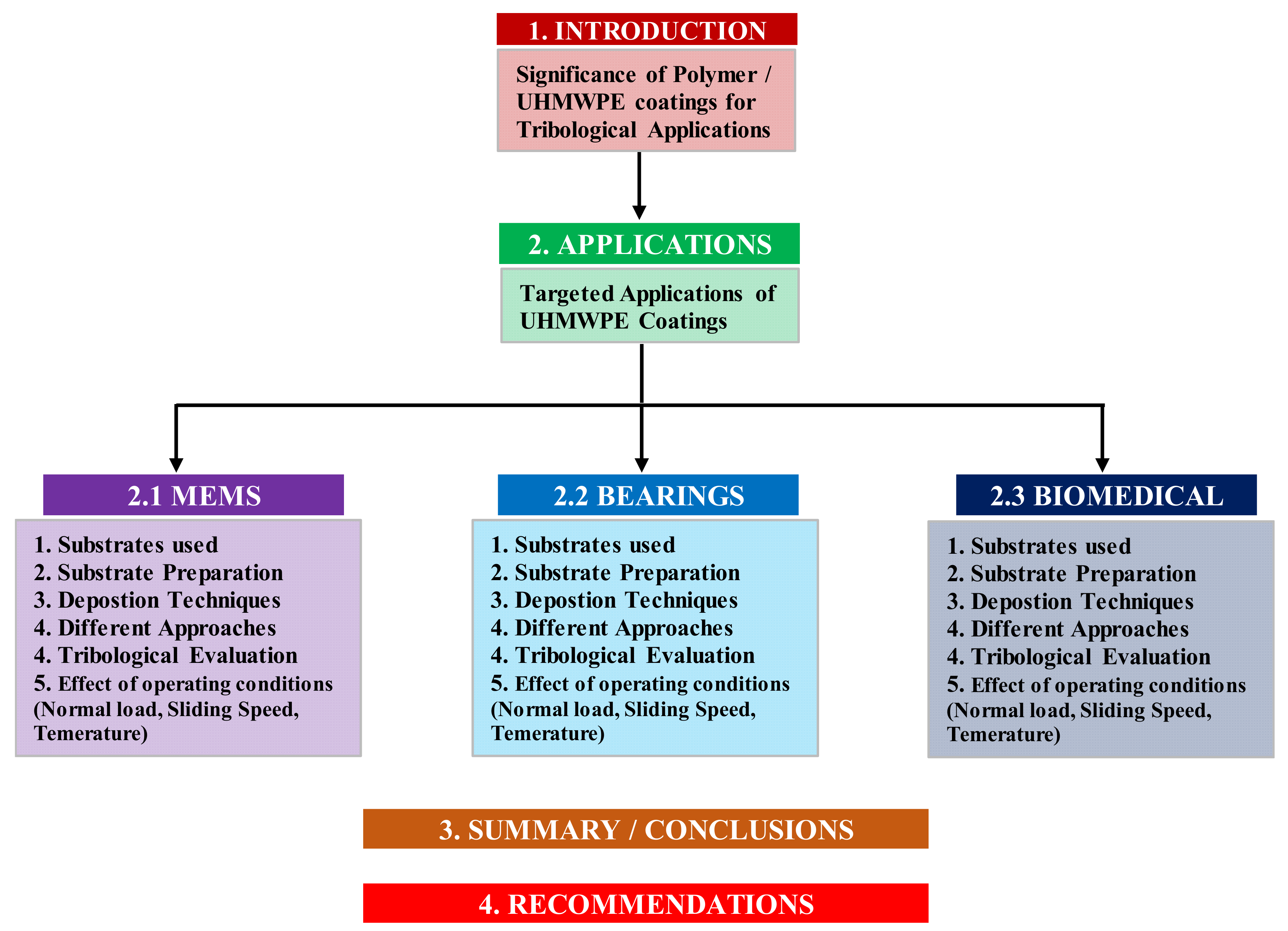

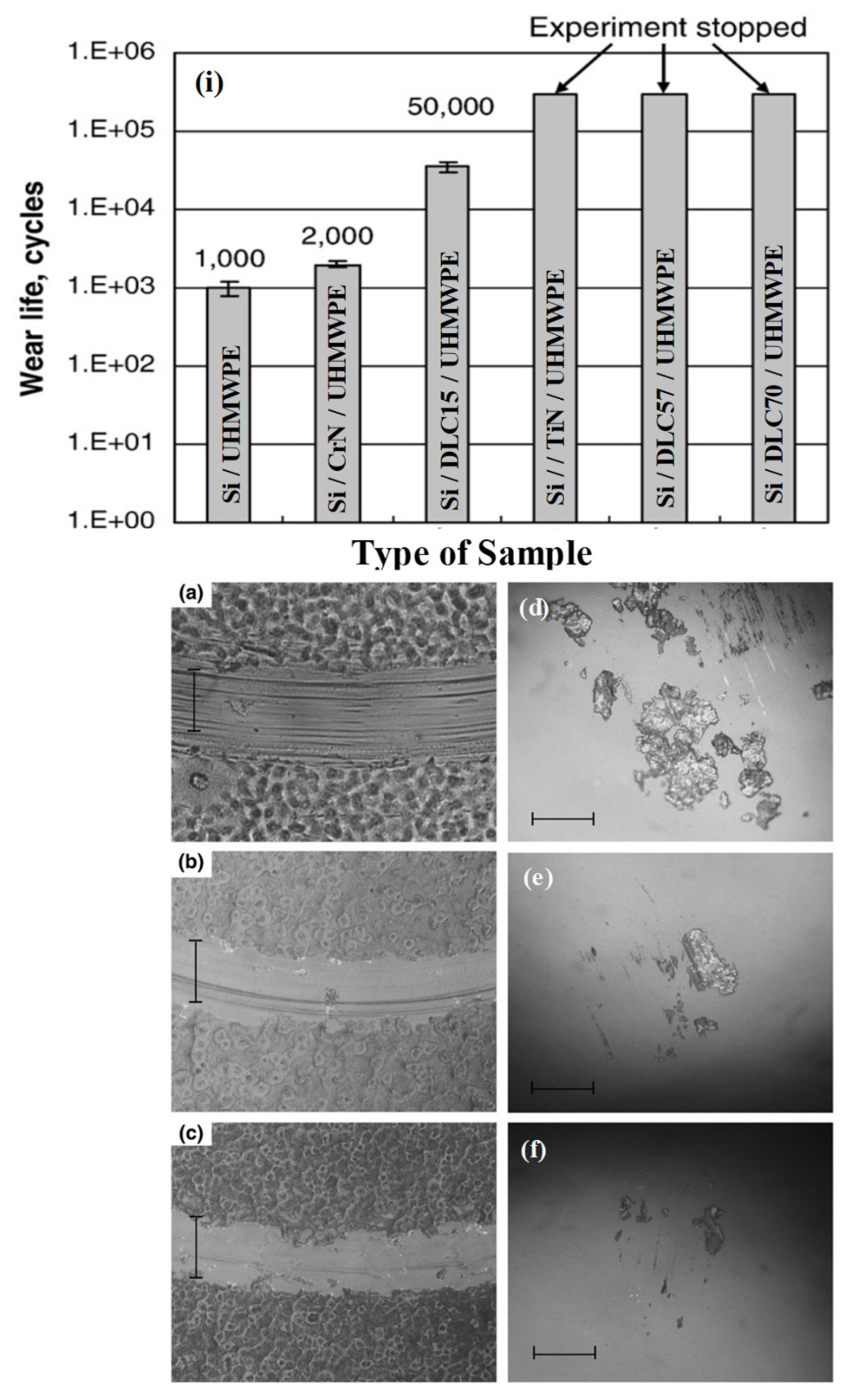

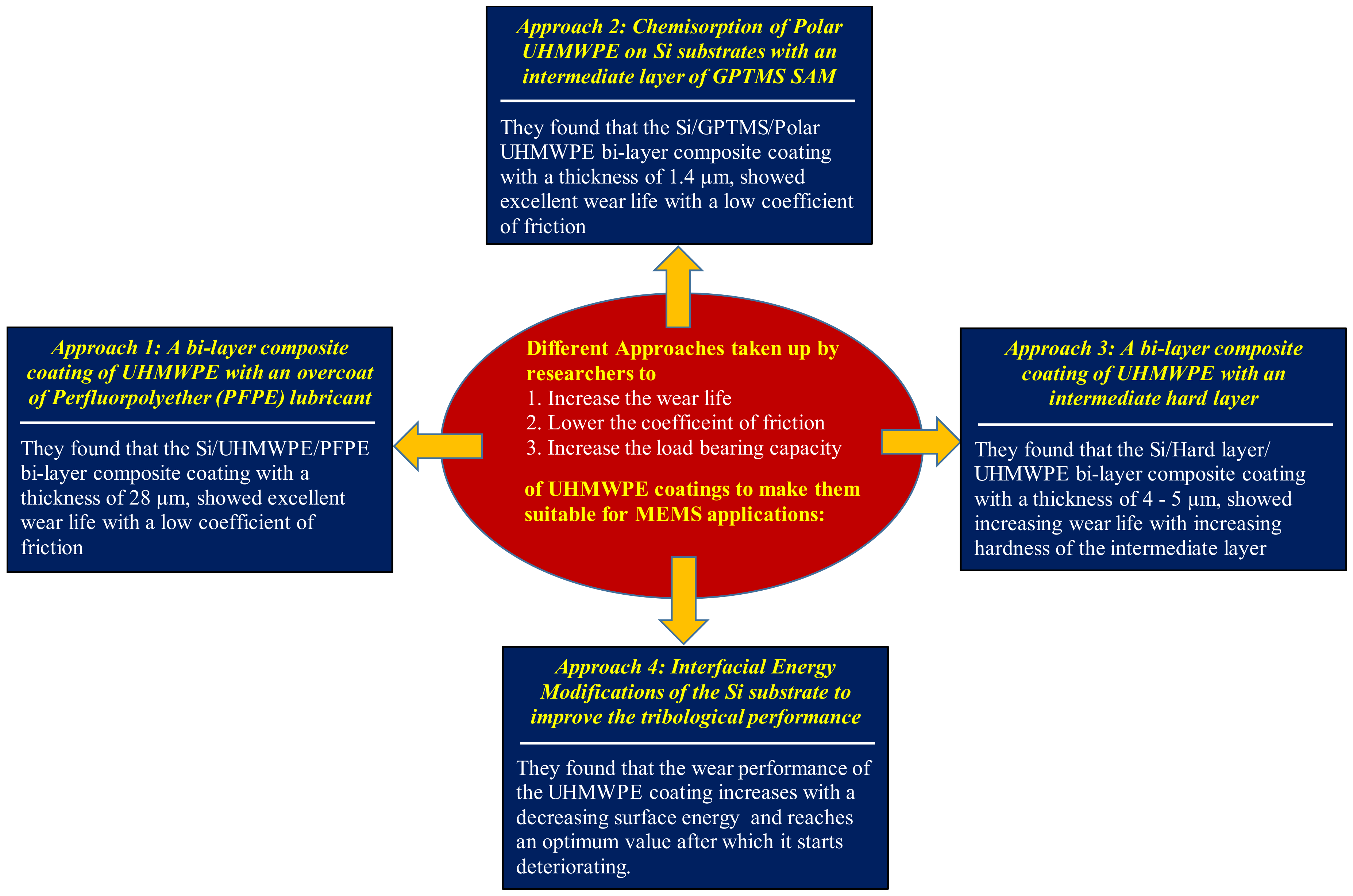

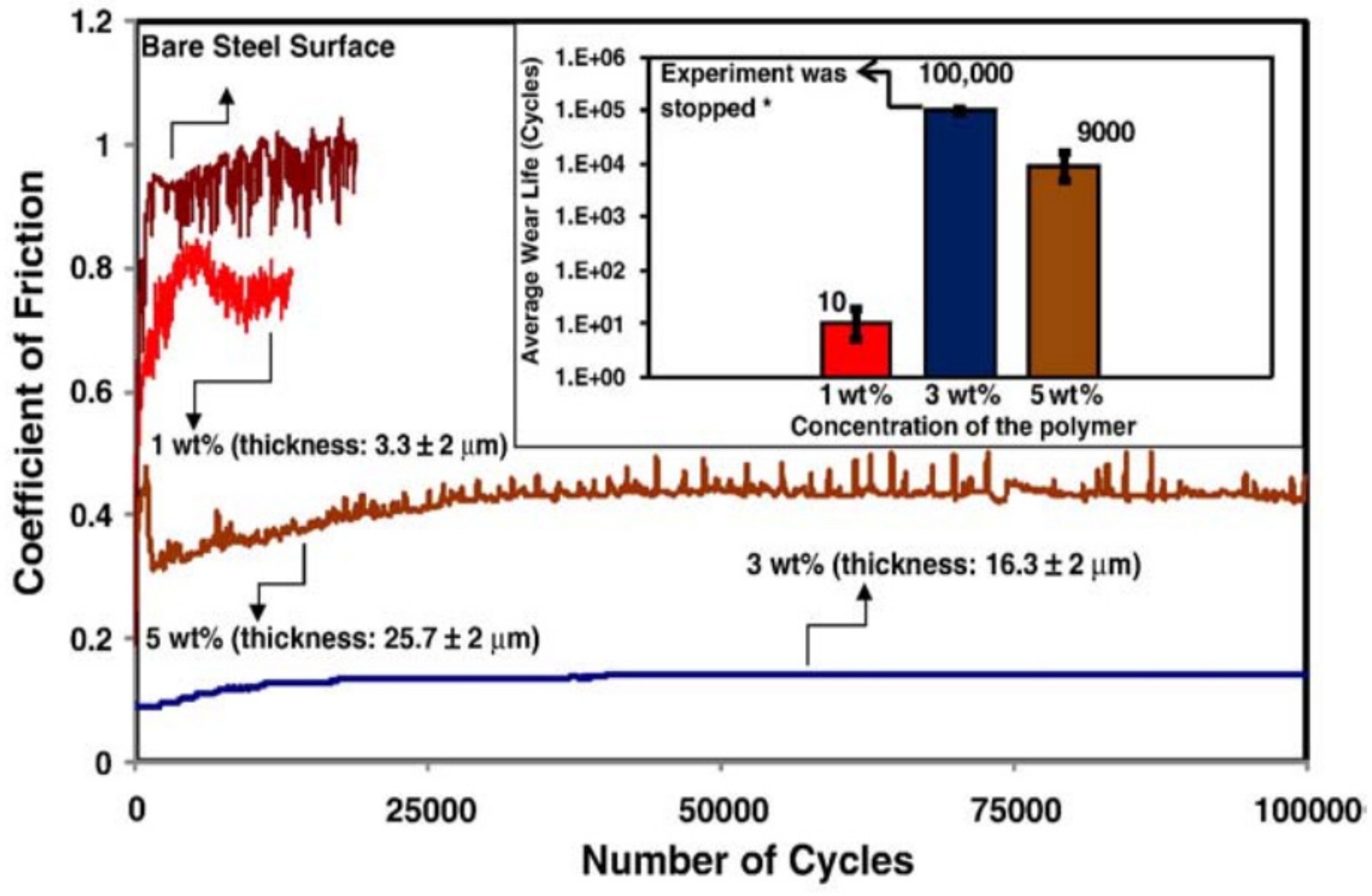
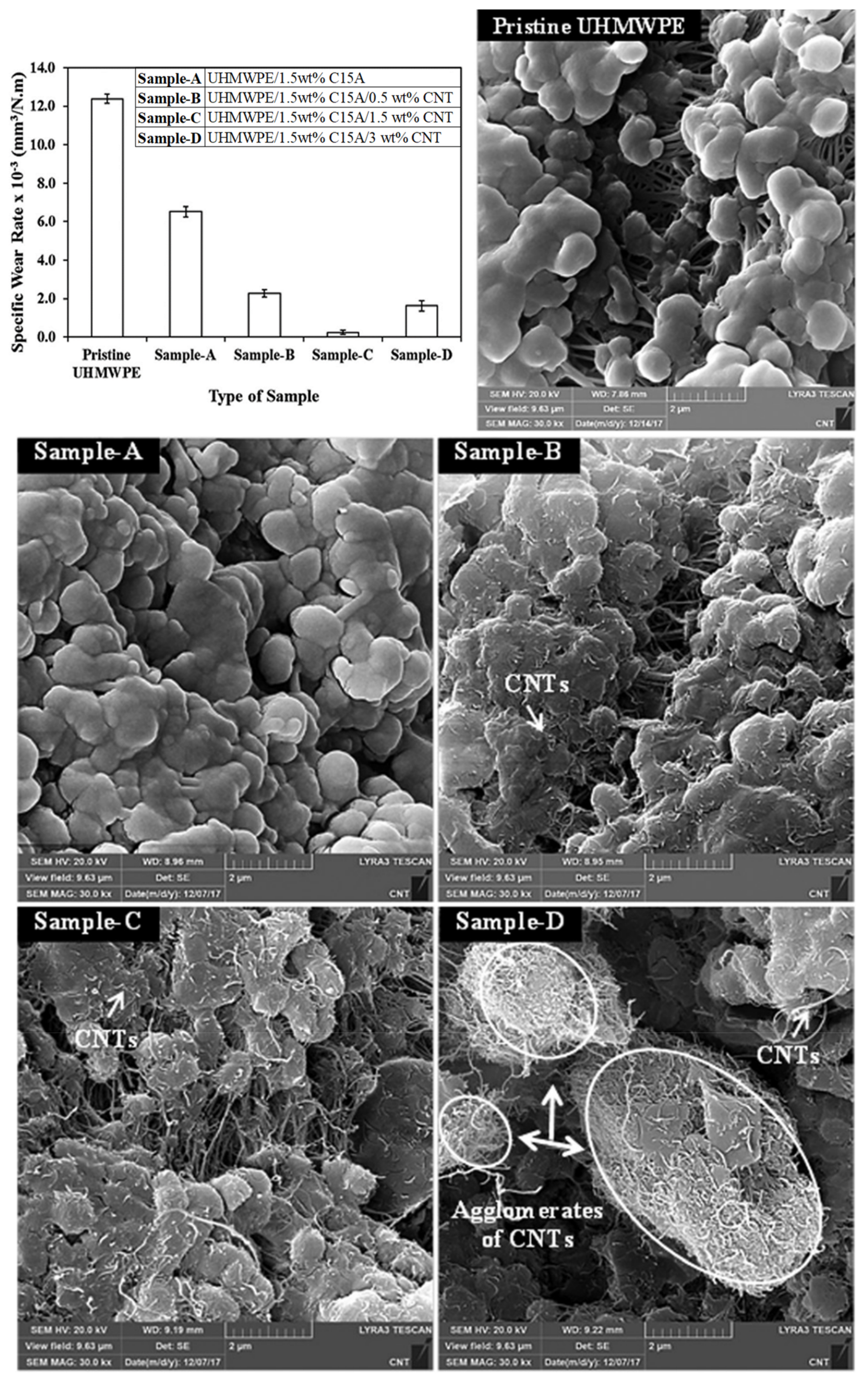
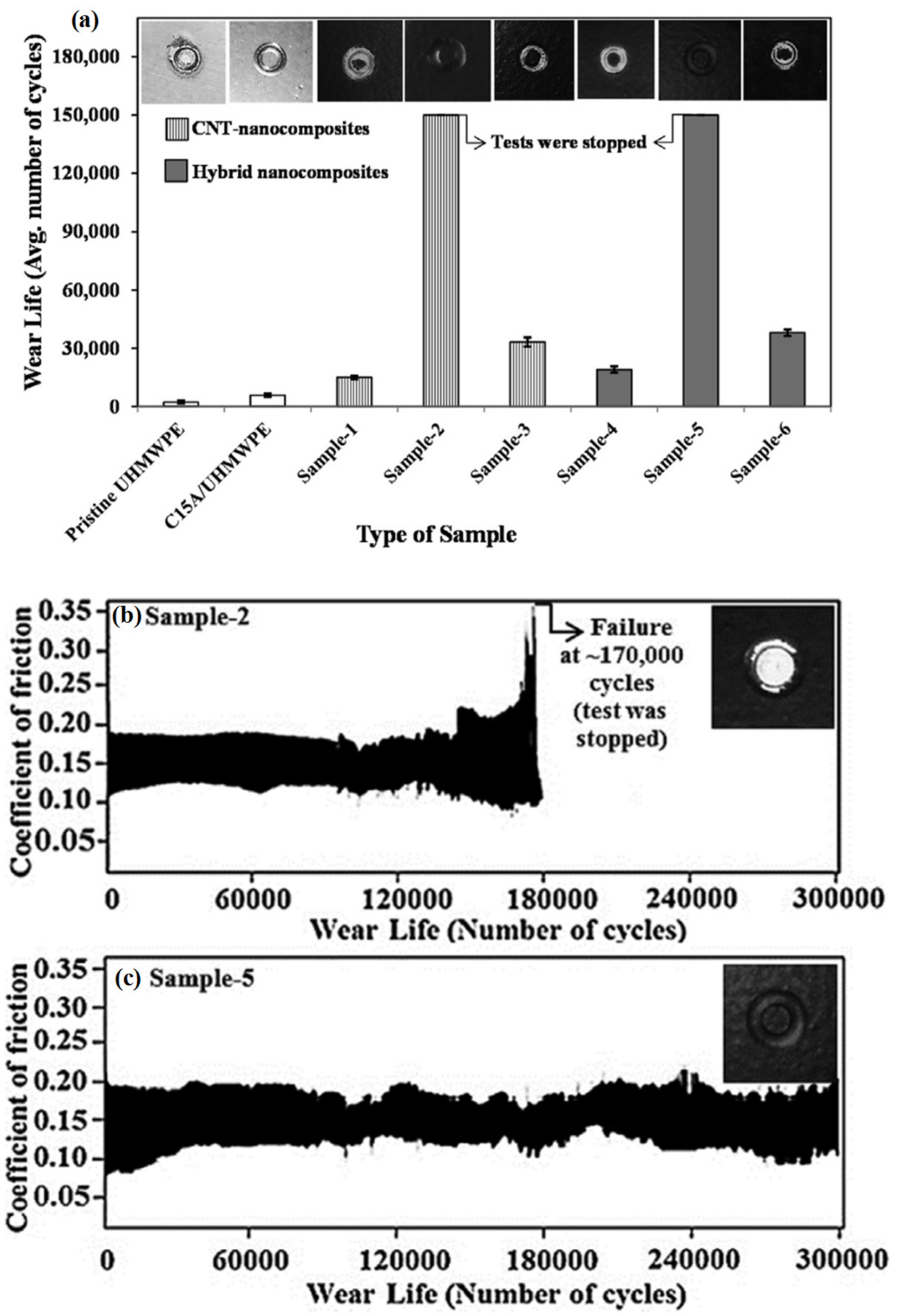
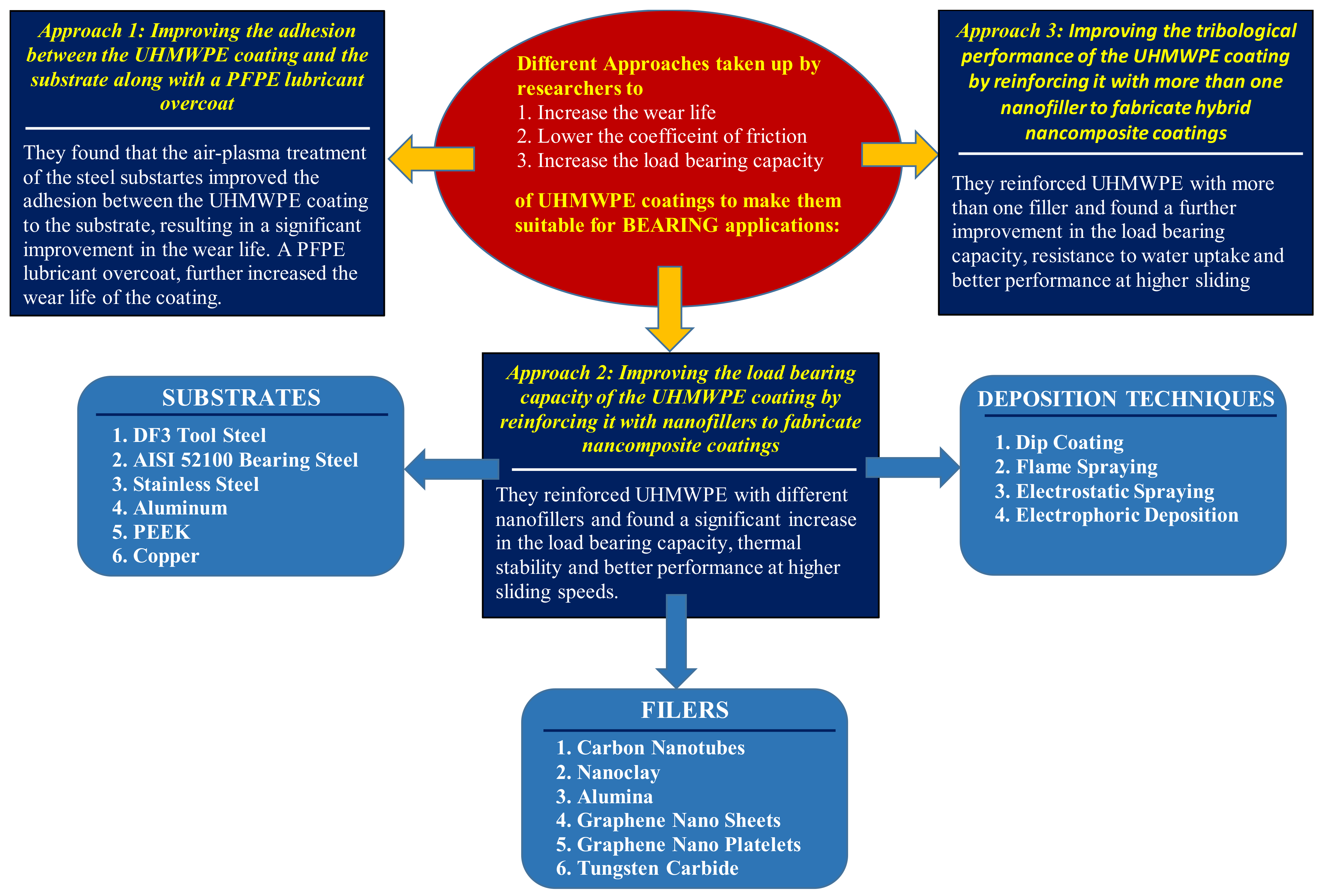
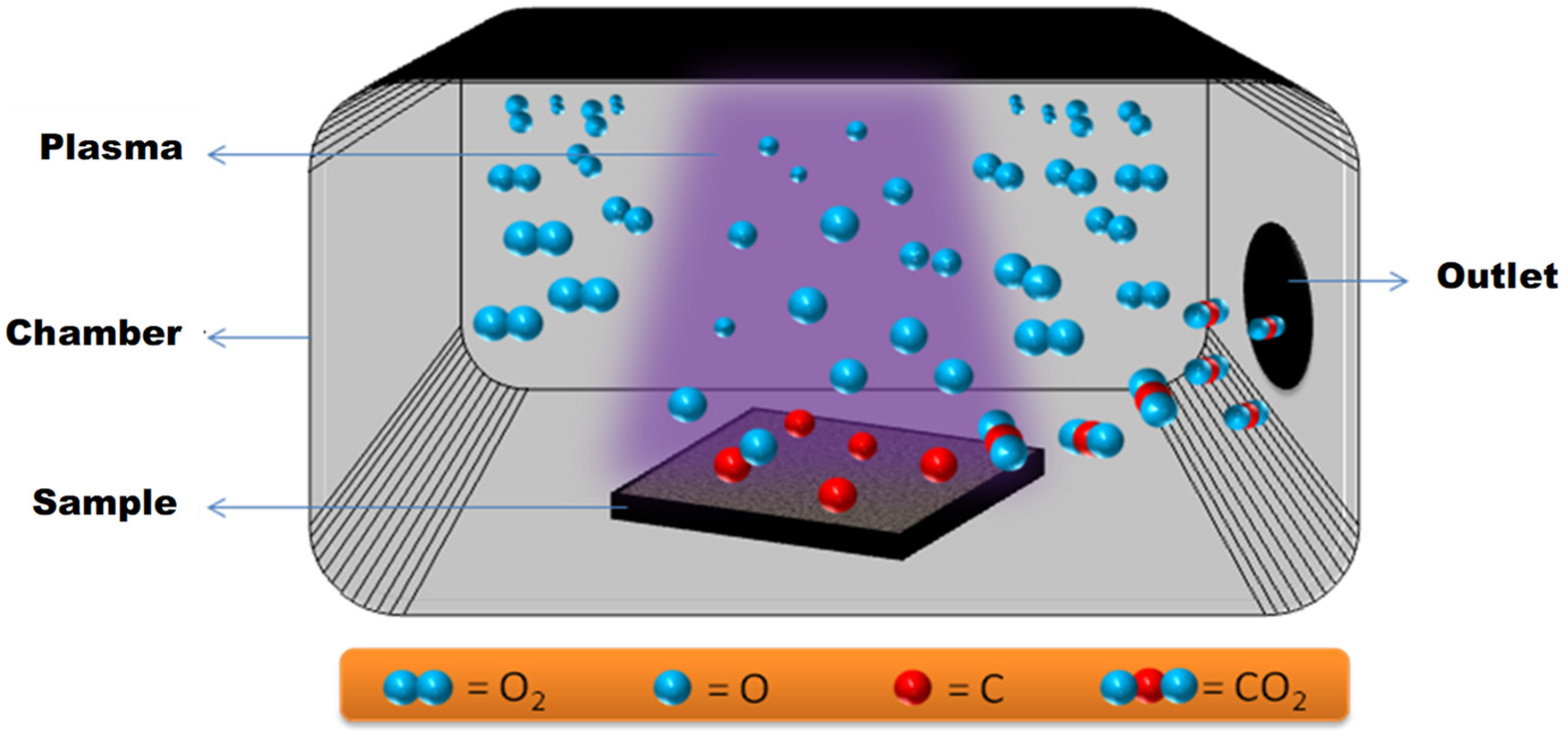

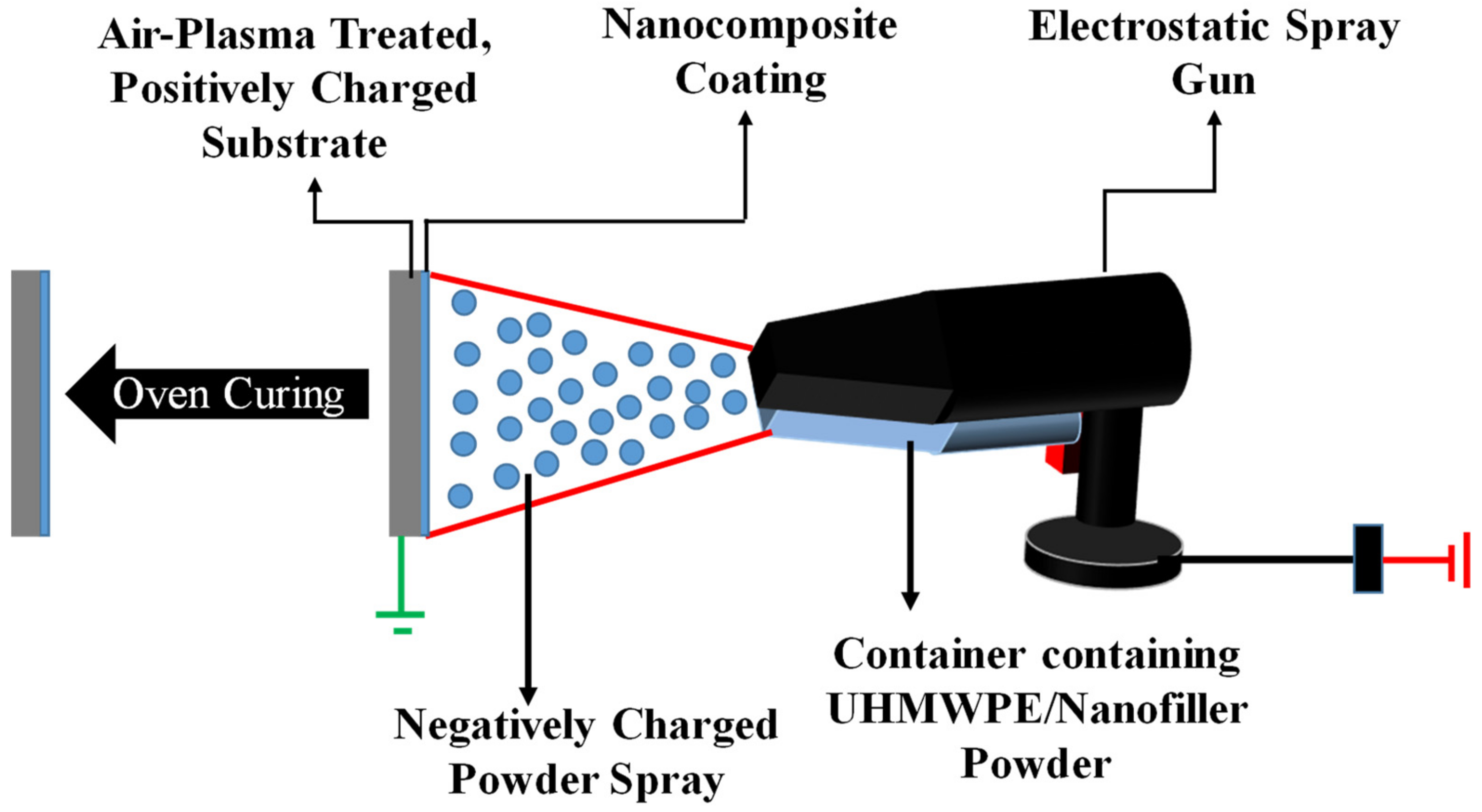
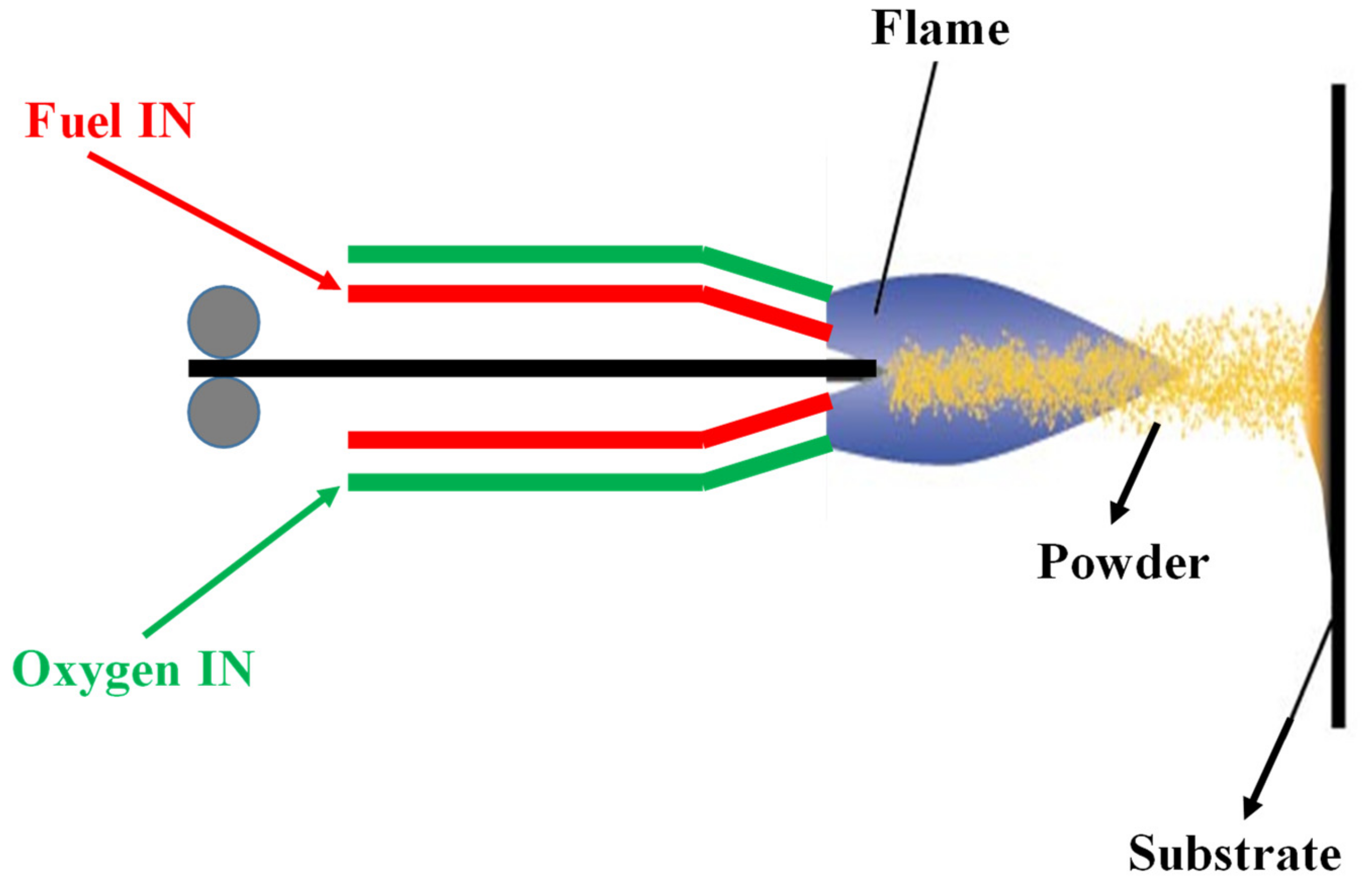
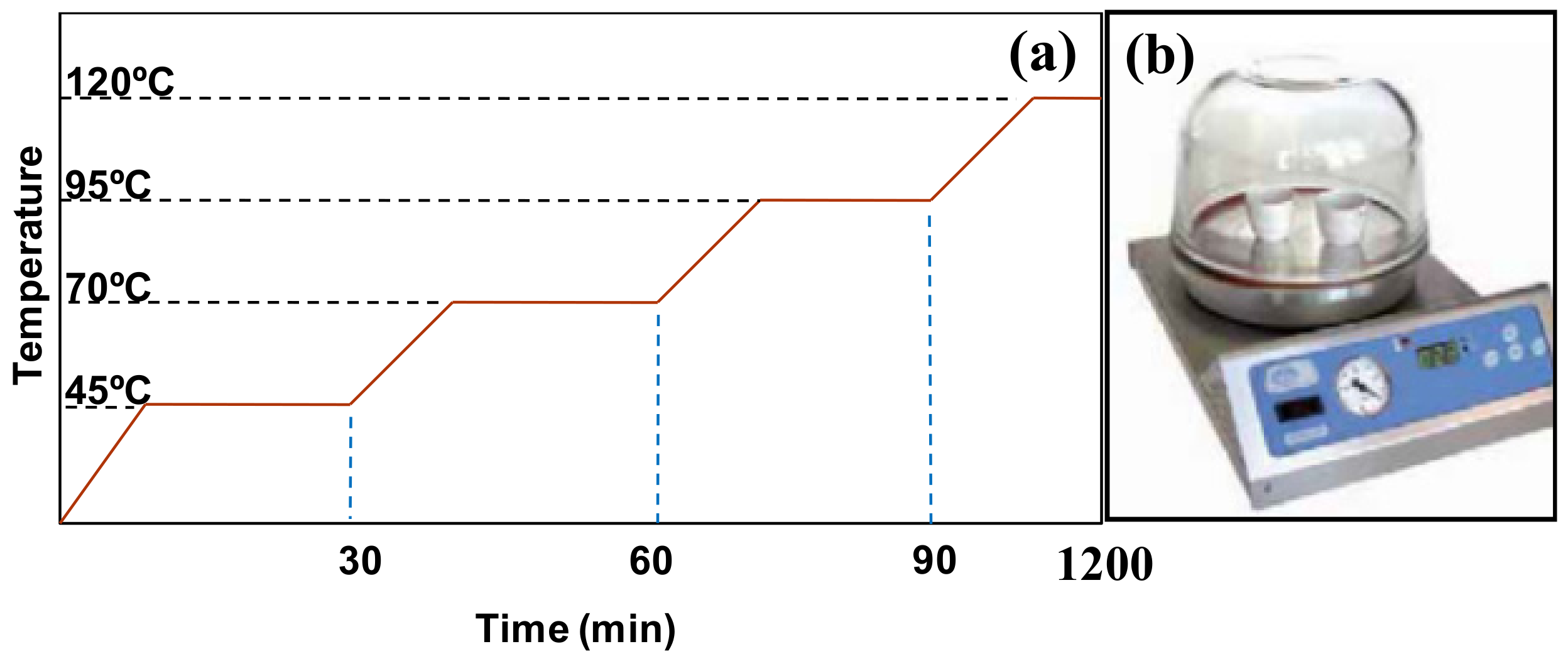

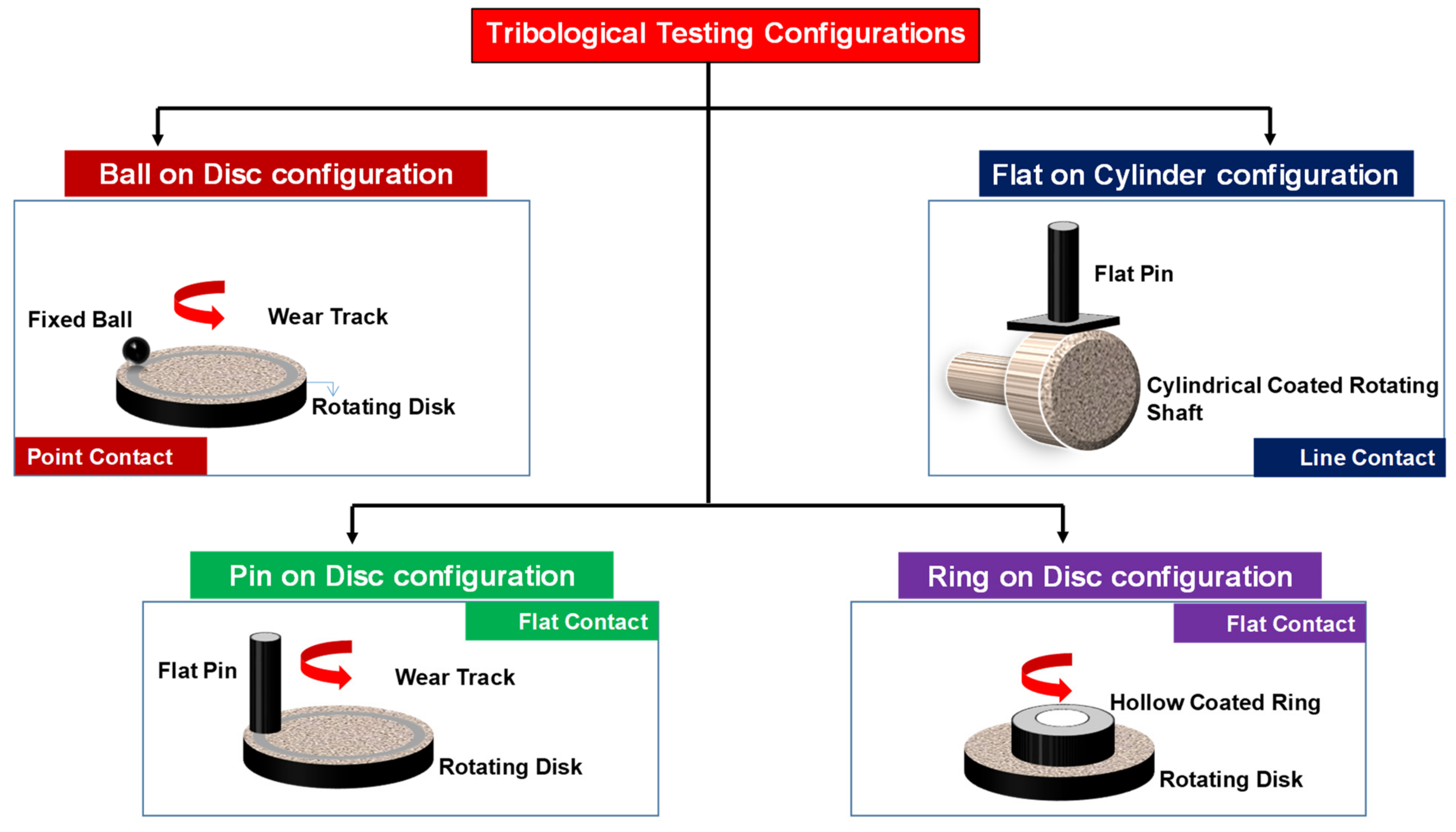

| Property | Value |
|---|---|
| Structure | 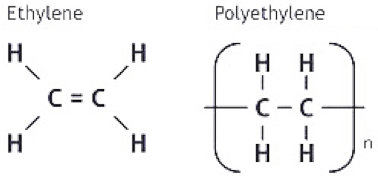 |
| Tensile strength | 38.6 to 43.8 MPa |
| Elastic Modulus | 0.69 GPa |
| Coefficient of Thermal Expansion | 234 to 360 10−6 °C |
| Melting Temperature Range | 138–142 °C |
| Working Temperature Range | −169 °C to 90 °C |
| Glass Transition Temperature | −110 °C |
| Poisson Ratio | 0.46 |
| Sample | Thickness (µm) | Water Contact Angle (°) | Coefficient of Friction | Wear Life (cycles) |
|---|---|---|---|---|
| Bare Si | - | 28 | 0.6 | <100 |
| Si/UHMWPE | 28 | 127 | 0.09 | ~12,000 |
| Si/UHMWPE/PFPE | 28 | 134 | 0.08 | >100,000 |
| Si/GPTMS | - | 52 | 0.46 | <100 |
| Si/GPTMS/Polar UHMWPE–With post heat treatment | 1.4 | 109 | 0.1 | >100,000 |
| Si/GPTMS/Polar UHMWPE–No post heat treatment | - | - | - | 6000 |
| Si/Polar UHMWPE | 1.4 | - | - | 3500 |
| Si/GPTMS/UHMWPE | - | - | - | 13,000 |
| Sample | WCA (°) | COF | Wear Life (Cycles) |
|---|---|---|---|
| Bare Si | 21 | 0.65 | 5 |
| Si/UHMWPE | 93 | 0.18 | 20,000 |
| Si/UHMWPE/PFPE | 95 | 0.06 | 100,000 |
| Si/DLC | 81 | 0.25 | 400 |
| Si/DLC/UHMWPE | 91 | 0.13 | 100,000 |
| Si/DLC/UHMWPE/PFPE | 102 | 0.07 | 300,000 |
| Concentration of UHMWPE Powder (wt.%) | Thickness of the Coating (µm) |
|---|---|
| 0.5 | 3.4 |
| 1 | 6.2 |
| 3 | 12.3 |
| 5 | 28 |
| Sample Type | WCA (°) | RMS (nm) | Carbon (%) | Oxygen (%) | Wear life (Cycles) |
|---|---|---|---|---|---|
| Si-Untreated | 38.4 | 0.53 | 17.7 | 37.6 | 500 |
| Si–Piranha Treated | 21.3 | 0.25 | 19.7 | 34.3 | 2000 |
| Si–Air plasma treated | 4.3 | 0.29 | 16.9 | 42.9 | 50,000 |
| Property | Value |
|---|---|
| Water contact angle (°) | 139 ± 3 |
| Thickness (µm) | 55 ± 4 |
| Hardness (MPa) | 97 ± 9 |
| Elastic modulus (GPa) | 3.76 ± 0.55 |
| Thermal conductivity (W/mK) | 0.64 ± 0.03 |
| Ref | Pre-Treatment | Coating Type | Operating Conditions | Counter face (Dia/mm, Ra/nm) | Wear Life (Cycles) | COF | UHMWPE Coating Thickness (µm) | Remarks | |
|---|---|---|---|---|---|---|---|---|---|
| Load (N) | Speed (m/s) | ||||||||
| [52] | Piranha | Si/UHMWPE/PFPE | 0.07 | 0.042 | Si3N4 (4, 20) | >100,000 | 0.06 | 28 |
|
| [53] | Piranha | Si/GPTMS/Polar UHMWPE | 0.3 | 0.042 | Si3N4 (4, 20) | ~6000 | 0.6 | 1.4 |
|
| Si/GPTMS/Polar UHMWPE/Post-heat treated (110 °C) | 0.3 | 0.042 | Si3N4 (4, 20) | >100,000 | 0.1 | 1.4 | |||
| [54] | Piranha | Si/DLC | 0.04 | 0.052 | Si3N4 (4, 20) | 400 | 0.25 | - |
|
| Si/UHMWPE | 0.04 | 0.052 | Si3N4 (4, 20) | 20,000 | 0.18 | 28 | |||
| Si/DLC/UHMWPE | 0.04 | 0.052 | Si3N4 (4, 20) | 100,000 | 0.13 | 28 | |||
| Si/DLC/UHMWPE/PFPE | 0.04 | 0.052 | Si3N4 (4, 20) | >300,000 | 0.06 | 28 | |||
| [55] | Piranha | Si/CrN (hardness = 13.5 GPa)/UHMWPE | 0.04 | 0.052 | Si3N4 (4, 20) | 2000 | 0.25 | 5 |
|
| Si/DLC (hardness = 15 GPa)/UHMWPE | 0.04 | 0.052 | Si3N4 (4, 20) | 50,000 | 0.14 | 5 | |||
| Si/TiN (hardness = 24 GPa)/UHMWPE | 0.04 | 0.052 | Si3N4 (4, 20) | 100,000 | 0.13 | 5 | |||
| Si/DLC (hardness = 57 GPa)/UHMWPE | 0.04 | 0.052 | Si3N4 (4, 20) | 100,000 | 0.18 | 5 | |||
| Si/DLC (hardness = 70 GPa)/UHMWPE | 0.04 | 0.052 | Si3N4 (4, 20) | 100,000 | 0.05 | 5 | |||
| [57] | - | Si (WCA = 21°)/UHMWPE | 0.04 | 0.1 | Si3N4 (4, 20) | 1000 | 0.17 | 6 |
|
| Si (heated) (WCA = 46°)/UHMWPE | 0.04 | 0.1 | Si3N4 (4, 20) | 60,000 | 0.17 | 6 | |||
| Si / APTMS (WCA = 52°)/UHMWPE | 0.04 | 0.1 | Si3N4 (4, 20) | 100,000 | 0.17 | 6 | |||
| Si-H (WCA = 71°)/UHMWPE | 0.04 | 0.1 | Si3N4 (4, 20) | 250,000 | 0.17 | 6 | |||
| Si/OTS (WCA = 104°)/UHMWPE | 0.04 | 0.1 | Si3N4 (4, 20) | 6500 | 0.17 | 6 | |||
| [58] | Piranha and Air-plasma treatment | Si (Untreated)/UHMWPE | 1 | 0.042 | Si3N4 (4, 20) | 500 | - | 16.3 |
|
| Si (Piranha)/UHMWPE | 1 | 0.042 | Si3N4 (4, 20) | 2000 | - | 15.2 | |||
| Si (Air-Plasma)/UHMWPE | 1 | 0.042 | Si3N4 (4, 20) | 50,000 | 0.1 | 16.6 | |||
| Ref | Substrate/ Pre-Treatment | Fillers (wt.%)/ Dispersion Technique | Operating Conditions | Type of Test/Counter Face (Dia mm) | Wear Life (Cycles) | COF | Coating Thickness (µm)/ Deposition Technique | Remarks | |
|---|---|---|---|---|---|---|---|---|---|
| Load (N) | Speed (m/s) | ||||||||
| [60] | DF3 Tool Steel/Air-Plasma Treated | - | 0.3 | 0.02 | Ball on disk/Ball: Si3N4 (4) | >100,000 | 0.14 | 16.3/Dip-Coating |
|
| [61] | DF3 Tool Steel/Air-Plasma Treated | Carbon Nanotubes (CNTs: 0.05, 0.1, 0.2)/Sonication and magnetic stirring | 4 | 0.26 | Ball on disk/Ball: Si3N4 (4) | >10 million | 0.16 | 55 ± 4/Dip-Coating |
|
| [62] | AISI 52100 Bearing Steel/Air-Plasma Treated | Carbon Nanotubes (CNTs: 0.1)/Sonication and magnetic stirring | 4 | 0.52 | Ball on disk / Ball: - Si3N4 (4) - Brass (4) - Stainless Steel (4) | >1 million | 0.11 | 55 ± 4/Dip-Coating |
|
| [63] | AISI 52100 Bearing Steel/Air-Plasma Treated | Carbon Nanotubes (CNTs: 0.1)/Sonication and magnetic stirring | 60 | 0.11 | Plate on cylinder/Plate: AISI 52100 bearing steel | 150,000 | 0.14 | 55 ± 4/Dip-Coating |
|
| [64] | Aluminum/Air-Plasma Treated | Carbon Nanotubes (CNTs: 0.1)/Sonication and magnetic stirring | 45 | 0.57 | Plate on cylinder/Plate: Aluminum (Dry conditions) | > 2 million | 0.17 | 55 ± 4/Dip-Coating |
|
| 60 | 0.11 | Plate on cylinder/Plate: Aluminum (Base oil Lubricated conditions) | > 3 million | 0.11 | 55 ± 4/Dip-Coating | ||||
| [65] | 304L Stainless steel/Grid Blasted/pre-heated to 110–130 °C | Graphene Nanosheets (GNs: 0.15, 0.3, 1) | 35 | 0.01 | Ball on disk/Ball: 304L Stainless steel (9.5) | - | 0.18 | Flame spraying |
|
| [66] | PEEK/Air-Plasma treated | - | 7 | 0.1 | Ball on disk/Ball: 440C Stainless steel (6.3) | 250,000 | 0.09 | 27 ± 2/Dip-Coating |
|
| [67] | PEEK/Air-Plasma treated | Carbon Nanotubes (CNTs: 0.1 and 0.2)/Sonication and magnetic stirring | 9 | 0.2 | Ball on disk/Ball: 440C Stainless steel (6.3) | >25,000 | 0.09 | 7.5 ± 2/Dip-Coating | |
| [68] | Aluminum/Air-Plasma treated/pre-heat treated at 180 °C (5 min) | Nanoclay (C15A: 0.5, 1.5 and 3)/Sonication and magnetic stirring | 9 | 0.1 | Ball on disk/Ball: 440 C Stainless steel (6.3) | >100,000 | 0.16 | 125 ± 4/Electrostatic spraying |
|
| [69] | Aluminum/Air-Plasma treated | Graphene Nanoplatelets (GNPs: 0.25, 1 and 2)/Sonication and magnetic stirring | 15 | 0.1 | Pin on disk/Pin: Hardened tool steel (3) | - | 0.3 | 96 ± 4.7/Electrostatic spraying |
|
| [70] | Aluminum/Air-Plasma treated | Graphene Nanoplatelets (GNPs: 1)/Sonication and magnetic stirring | Contact Pressures: 0.1, 0.5, 0.8, 1 MPa | 1, 1.5, 2 | Ring on disk/Disk: AISI 4140 steel (125) (dry and lubricated conditions) | - | - | 94 ± 6/Electrostatic spraying |
|
| [71] | AA2028 Al alloy/Air-Plasma treated | Graphene Nanoplatelets (GNPs: 0.5, 1 and 2)/Sonication and magnetic stirring | 35 N | 0.5 | Pin on disk / Pin: Silver Steel BS-1407 (3) | - | - | 99.34 / Electrostatic spraying |
|
| [72] | Steel/Air-Plasma treated/pre-heat treated at 180 °C (5 min) | Alumina (Al2O3: 0.5, 3, 5 and 10)/Sonication and magnetic stirring | 12 | 0.1 | Ball on disk/Ball: 440C Stainless steel (6.3) | >250,000 | 0.13 | 60 ± 3/Electrostatic spraying |
|
| [73] | Copper (Cu) | Nickel | 2 | 0.1 | Ball on disk/Ball: 304L Stainless steel (4) | - | 8 ± 1/Eletrophoric/Electro plating deposition |
| |
| [74] | Low alloyed Steel/Air-Plasma treated /pre-heat treated at 180 °C (5 min) | Tungsten arbide (WC: 1, 3, 6 and 9)/Sonication and magnetic stirring | - | - | - | - | - | 85 ± 5/Electrostatic spraying |
|
| [75] | Aluminum / Air-Plasma treated/pre-heat treated at 180 °C (5 min) | HYBRID–Nanoclay (C15A: 1.5) + Carbon Nanotubes (CNTs: 0.5, 1.5 and 3)/Sonication and magnetic stirring | 12 | 0.1 | Ball on disk/Ball: 304L Stainless steel (4)–Dry conditions | >100,000 | 0.16 | 180 ± 3/Electrostatic spraying |
|
| [76] | Aluminum/Air-Plasma treated/pre-heat treated at 180 °C (5 min) | HYBRID–Nanoclay (C15A: 1.5) + Carbon Nanotubes (CNTs: 0.5, 1.5 and 3)/Sonication and magnetic stirring | 12 | 0.1 | Ball on disk/Ball: 304L Stainless steel (4)–Water lubricated conditions | 300,000 | 0.12 | 180 ± 3/Electrostatic spraying |
|
| Ref | Substrate/ Pre-Treatment | Fillers (wt.%)/Dispersion Technique | Operating Conditions | Type of Test/Counter Face (Dia mm) | Wear Life (Cycles) | COF | Coating Thickness (µm)/Deposition Technique | Remarks | |
|---|---|---|---|---|---|---|---|---|---|
| Load (N) | Speed (m/s) | ||||||||
| [79] | Titanium alloy (Ti6Al4V) /Air-Plasma Treated | - | 4 | 0.083 | Ball on disk/Ball: Si3N4 (4) | >175,000 | 0.10 | 19.6 ± 2.0/Dip-Coating (withdrawal speed = 1.9 mm/s, soaking time = 35 s) |
|
| [80] | Titanium alloy (Ti6Al4V)/Air-Plasma Treated | HYBRID–Carbon Nanotubes (CNTs: 0.5, 1.5 and 3) + Hydroxyapatite (HA: 0.5, 1.5, 3 and 5)/Sonication and magnetic stirring | 7, 9, 12, 15 | 0.1 | Ball on disk/Ball: 440C Stainless steel (6.3) | 250,000 | 0.15 | 181 ± 4/Electrostatic spraying technique |
|
Publisher’s Note: MDPI stays neutral with regard to jurisdictional claims in published maps and institutional affiliations. |
© 2021 by the author. Licensee MDPI, Basel, Switzerland. This article is an open access article distributed under the terms and conditions of the Creative Commons Attribution (CC BY) license (http://creativecommons.org/licenses/by/4.0/).
Share and Cite
Abdul Samad, M. Recent Advances in UHMWPE/UHMWPE Nanocomposite/UHMWPE Hybrid Nanocomposite Polymer Coatings for Tribological Applications: A Comprehensive Review. Polymers 2021, 13, 608. https://doi.org/10.3390/polym13040608
Abdul Samad M. Recent Advances in UHMWPE/UHMWPE Nanocomposite/UHMWPE Hybrid Nanocomposite Polymer Coatings for Tribological Applications: A Comprehensive Review. Polymers. 2021; 13(4):608. https://doi.org/10.3390/polym13040608
Chicago/Turabian StyleAbdul Samad, Mohammed. 2021. "Recent Advances in UHMWPE/UHMWPE Nanocomposite/UHMWPE Hybrid Nanocomposite Polymer Coatings for Tribological Applications: A Comprehensive Review" Polymers 13, no. 4: 608. https://doi.org/10.3390/polym13040608







